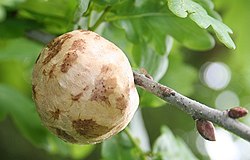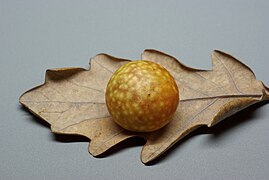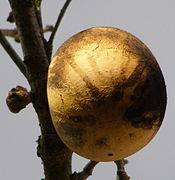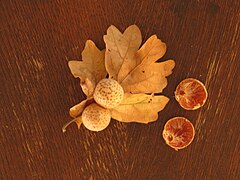Oak apple
This articleneeds additional citations forverification.(May 2023) |



Oak appleoroak gallis the common name for a large, round, vaguely apple-likegallcommonly found on many species ofoak.Oak apples range in size from 2 to 4 centimetres (1 to 2 in) in diameter and are caused by chemicals injected by thelarvaof certain kinds ofgall waspin the familyCynipidae.[1]
Formation
[edit]The adult female wasp lays single eggs in developing leafbuds.The wasp larvae feed on the galltissueresulting from theirsecretions,which modify the oak bud into the gall, a structure that protects the developing larvae until they undergometamorphosisinto adults.
Some common oak-apple-forming species are theBiorhiza pallidagall wasp in Europe,Amphibolips confluentain eastern North America, andAtrusca bellain western North America.[1]Oak apples may be brownish, yellowish, greenish, pinkish, or reddish.
Other galls
[edit]Considerable confusion exists in the general literature between the oak apple and theoak marble gall.The oak marble is frequently called the oak apple due to the superficial resemblance and the preponderance of the oak marble gall in the wild. Other galls found on oak trees include theoak artichoke galland theacorn cup gall,but each of these has its own distinctive form.
Iron gall ink
[edit]Oak galls have been used in the production of ink since at least the time of theRoman Empire.From theMiddle Agesto the early twentieth century, iron gall ink was the main medium used for writing in the Western world.[2]
Gall nuts are a source oftanninin the production of iron gall ink. Tannins belong to a group of molecules known as polyphenols and can be taken from different parts of plants such as leaves, pods, fruits, and gall nuts.
Along with gall nuts, other important ingredients in the production of iron gall ink includeiron sulfateandgum arabic.The reaction between the tannins from the gall nut and the iron produces a complex that gives the iron gall ink its color. The gum arabic makes the ink more viscous and helps bind the ink to the writing surface.[3]
Folklore
[edit]It is said that if a "worm" is found inside the gall onMichaelmas Day,then the year will be pleasant and unexceptional, and if a spider is found, then it will be a bad year with shortages and ruined crops. If a fly is found inside, then it will be a moderate season, and if nothing is found, then serious diseases will occur all that year.[4]
Oak Apple Day(or Royal Oak Day) is a former public holiday inEnglandon 29 May that commemorated theRestorationofCharles IIin 1660. The popular name refers to the event during theEnglish Civil Warwhen Charles hid in anoak tree.The commemoration persists in some areas today, although festivities have little to do with the Restoration.
Gallery
[edit]-
An oak apple on an oak leaf.
-
Oak apples
-
Anoaktree with multiple oak apples.
-
Andricus kollarioak gall
-
Oak apples on an oak tree.
-
Oak apple gall on Garry oak (Quercus garryana)
-
Oak apples on oak leaf and in cross section
-
Biorhiza pallidamale
List of galls called oak apples
[edit]| Image | Binomial name | Host species | Region |
|---|---|---|---|

|
Andricus quercuscalifornicus[5] | valley oak,California scrub oak | North America |
| Atrusca bella[5] | Arizona white oak,Mexican blue oak,netleaf oak,Toumey oak,andshrub live oak | North America | |

|
Atrusca brevipennata[5] | shrub live oak,Gambel oak | North America |
 |
Atrusca capronae[5] | shrub live oak | North America |

|
Besbicus mirabilis[5] | Oregon oak | North America |
 |
Trichoteras coquilletti[5] | Huckleberry oak,canyon live oak | North America |
 |
Trichoteras vacciniifoliae[5] | Huckleberry oak, canyon live oak | North America |
See also
[edit]References
[edit]- ^abCranshaw, Whitney (2004).Garden Insects of North America.Princeton, New Jersey: Princeton University Press.ISBN0-691-09560-4.
- ^Diringer, David (1 March 1982).The Book Before Printing: Ancient, Medieval and Oriental.Dover Publications. pp. 551–2.
- ^"Iron Gall Ink".travelingscriptorium.library.yale.edu.21 March 2013.Retrieved24 May2023.
- ^Roud, Steven (2003).The Penguin Guide to the Superstitions of Britain and Ireland.Penguin Books. p. 344.
- ^abcdefgRusso, Ronald A. (2021).Plant Galls of the Western United States.Princeton University Press. p. 124.doi:10.1515/9780691213408.ISBN978-0-691-21340-8.LCCN2020949502.








